January 2011
The Noise
The Outs
Ellen Jo Roberts
“Eliphante is unique in all the world, born from the pure creative well at the core of the human spirit, unhampered by regulations from without. As a result, it speaks to that place of creative power in each of us, and most people respond with both awe and excitement about the possibilities of really living by one's inner striving for beauty, really making it manifest, in all aspects of one's life.”
-Alna Laurel, director of Eliphante.
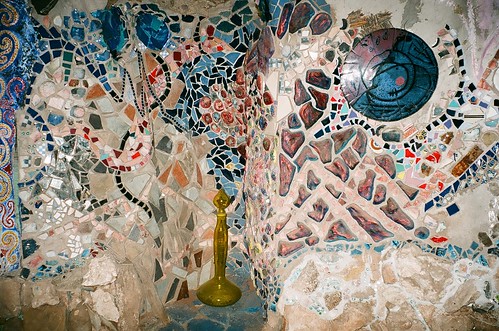
Beginning around 1979, and continuing for the better part of three decades, Michael and Leda Kahn created a magical folk art installation along the sycamore and mesquite-lined banks of Oak Creek in Cornville, Arizona. The entire complex is known as “Eliphante”, named after the first structure created, which resembles, with its ear-side doors and river wood snout, an elephant of sorts. Several buildings followed: the “Hippodome”, “Pipe Dreams”, smaller houses, outdoor kitchen, amphitheater and assorted art installations. The structures and art spaces are all designed with native natural materials, sandstone, wood, salvaged glass, mylar, foil, tile and metal, and many years of creativity, love and hard work. With its faded astro-turf pathways, donated by a Sedona tennis club, it's like a surreal mixed-media miniature golf course. It’s an open-air museum of alternative possibilities. Eliphante is a dreamscape.
It is also currently endangered: threatened by decay, crumbling infrastructure, and sitting on land at risk of being sold and leveled.

Traveling from Provinceton, Massachussetts in a 1960 Ford truck they called “Botchi”, Michael and Leda Kahn arrived in the Sedona area in 1977, artistic visionaries looking for a new way of life. It was not long before the Kahns connected with the Croziers, the landowners of the acreage that includes Eliphante’s parcel. The Croziers were also transplants from “back east”, and soon the Kahns were invited to become caretakers of the property. . The Croziers are benevolent landlords, generous and philosophical. A dynamic relationship was developed.
“The property is at present still owned by the original owners who invited Mike and Leda as caretakers back in '79”, states Ms. Laurel, “They originally bought 120 acres as an active cattle ranch, not in operation for many years, and have sold some of it. They had owned it only a few years before Mike and Leda entered the picture.”
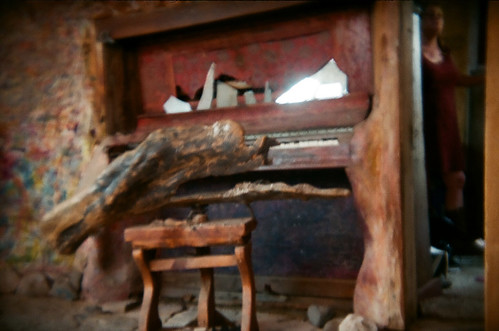
The Kahns were sheltered at first in a truck-bed camper during the warm seasons. “As autumn came along, Mike felt moved to begin constructing a warmer winter shelter by digging into the hillside back of their camp, with earth insulation in mind,” explains Ms. Laurel,
“He gathered rocks from the hillside and from a dry wash half a mile back of the camp area, where he walked daily, both morning and evening, and brought back as many rocks as he could carry on his back in burlap sacks slung over his shoulder. Sometimes it would be two or three good-size stones. Other times, one would be all he could manage, it was so big. Usually he would get Leda to go along and carry her fair share as well.”
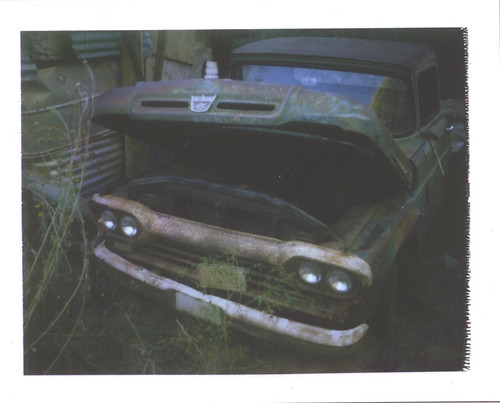
“The building called Eliphante was built to be the home of Michael and Leda, but became in process such a work of art that it was never lived in. Though it served as stage for weekly music jams for many years, and also sheltered a few overnight guests on occasion, with or without the knowledge of Mike and Leda,” says Ms. Laurel, “This building with no straight lines or flat surfaces, made of found objects both natural and man-made, combining such disparate elements as driftwood and old auto windshields, manages to evoke the same high wonder and longing for what is true and pure and good as Tolkein's Elvenhome of Rivendell. Or at least the Hobbit homes of the Shire. A longing for times more innocent when creativity was unfettered by rules and unconfined by preconceived ideas of how things must be.”

John Bianchini, a member of the Noise family (and former editor), is part of a small group of caretakers who currently inhabit Eliphante. An NAU journalism graduate originally from Salinas, California, Bianchini had the pleasure of meeting the Kahns in 2005, while taking photographs for a Noise feature written by Natasha Shealy. "Most who knew Michael cannot explain what Eliphante's intent was. It was never really an issue then. They do echo that Michael lived his life 'in-the-moment' and that he would just set-out and create these things whether or not people liked it or helped him.”
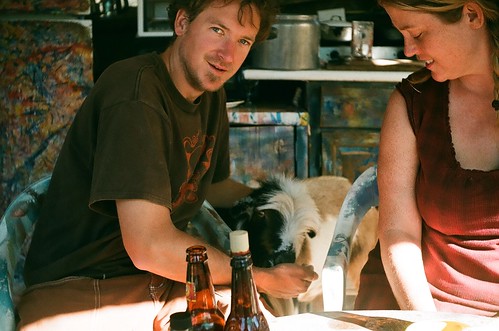
Mr. Bianchini is actively involved in the preservation of Eliphante, and rousing folks to action on its behalf. “They call us ‘caretakers’, but I like to think of myself as ‘Guerrilla Outreach’ because I try more to get people involved to decide what should be done before going out and just doing it.”
"For many people, Eliphante reflects individual perceptions of where we are mentally. While a few have been put-off by its poverty and ruggedness, most see it as a magical land just short of gnomes and fairies”, says Mr. Bianchini, "Living in art is a way-of-life; something most people yearn for. Americans don't have much art in their daily lives and that might be the reason for the decline of American civilization.”
In 1994, the Smithsonian American Art Museum catalogued Eliphante into its “SOS-Save Our Sculpture” public awareness project, a growing list of U.S. public sculptural art to be documented, and conserved.
Michael Kahn of Eliphante, Paolo Soleri of Arconsanti and renowned Arizona sculptor John Waddell were all friends, and are considered to be artistic contemporaries because, according to Mr. Waddell, they “all sought to create something that could change society,” and they were “the rare few with the training and skill, willing and able and disciplined enough to follow their vision despite the obstacles that would hold most people back.”
Verde Valley resident Waddell is fond of Eliphante and what it represents.
"Michael was a man who had a vision of a completely non-commercial form of art,” says Mr. Waddell, “That in of itself was the motivation and satisfaction that it was made not for the market but for the total being of heart, soul and mind."
Waddell believes Kahn's unique nature had roots in art history. Michael Kahn started as a conventional painter and gradually became non-objective in his handling of materials. This transferred into building of structures that were in a sense non-objective. "At Eliphante you have an account of his day to day experience of putting objects together in an interesting way...'The uniqueness of configuration' is a cohesive construct where he had the impulse to put these found materials together."
The sculptor thinks Eliphante hints at a different way of life where the normal impulse to earn money did not exist. In some cultures, money is not the primary value. “Anyone can be as creative as Michael was. If you can understand this then you are on a progression."
In 2008 Michael Kahn succumbed to Pick’s Disease, a form of Alzheimer’s. In his final years he lost the ability to communicate verbally, but this did not stop him from continuing his creative flourishes and projects at Eliphante.
After his death, Leda moved away, to Santa Fe, New Mexico,
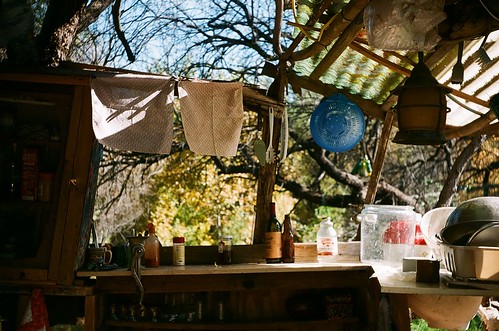
Alna Laurel is the director of Eliphante Ltd., a 501c3 art organization. Her working relationship with Eliphante began in the late 1990s, but her path to it started much earlier, in the mid-1970s, while camping with her father and sisters at the entrance to the old Sexton Ranch in Cornville. Her family camped in the location for years. “While there, my dad met a man who was buying property across the creek from our camp, and the two of them held many long discussions on spiritual and philosophic matters, to mutual satisfaction. When Dad decided to move on to other camping grounds, his friend expressed disappointment that the philosophizing days were to be over. But Dad assured him that someone else would come along to take Dad's place as a spiritual friend.”

Ms. Laurel grew up to lead a creative life unfettered by convention, yet full of travels, adventures, artistic pursuits, family, and continuing education. Fast forward to 1998. Ms. Laurel’s sister, Laurie, searched for their old camping grounds during a road trip through Arizona.
“Finding her way mostly by instinct to the general area she remembered as our home, my sister stopped to ask directions of someone who turned out to be Michael Kahn, out cleaning the culverts at the entrance to Eliphante. Mike said he did indeed know the man Laurie was looking for. He owned the land Mike was camping on. He invited Laurie to look around his camp, which she did with mounting enthusiasm and excitement about all the magical structures defying every common idea of what a building should be.”

“When she went on to meet our old friend who owned that land and had given Mike free reign to build according to his artistic spirit, he told her that Michael Kahn was the one who came along to take our Dad's place as a spiritual friend across the years. And the relationship had been mutually beneficial, the one providing a piece of land and the other a spiritual artistic vision and creative drive which together resulted in Eliphante, a magical inspiration to most who are lucky enough to visit it.
“Naturally, as soon as I could I went to see Eliphante as well, and fell in love with it like most people do who visit.” Ms. Laurel moved from Hawaii to Cornville, “But I didn't get much involved until near the end of Mike's life when his Pick's disease had progressed to the point of speechlessness on his part and plans to leave Eliphante on Leda's part.”
In 2008, Ms. Kahn was present to hear Leda Kahn’s lament about having no one to carry on Eliphante on after she left. “Moved by my love for the place, I boldly volunteered,” said Ms. Kahn, ”only to discover that I knew nothing whatsoever about how to carry it on! I didn't even know what a non-profit was, much less how to operate one.”
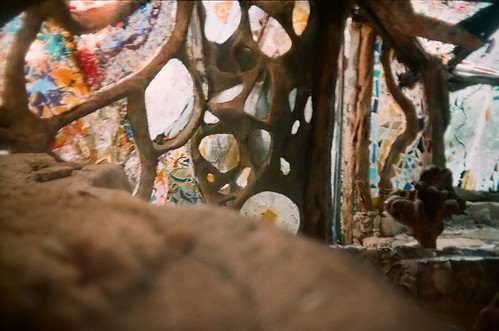
Caretakers Ryan Matson and Tracy Schinagel arrived from Portland in 2010, and have called Eliphante home since August, along with their clever and handsome dancing goat, Midas, who nibbles away at weeds and provides manure for gardening. Matson and Schinagel are energetic and artistic; a good blend for Eliphante.
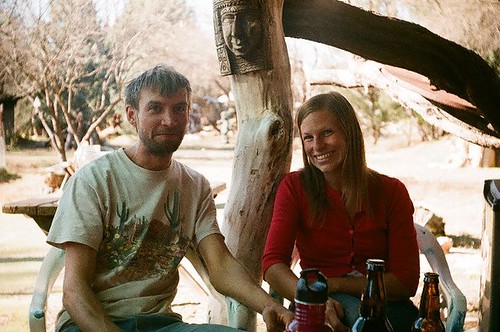
“I have never had the pleasure to meet the Kahns”, says Ms. Schinagel, a charming Tuscon native with a broad smile, “I feel like they created Eliphante out of the desire to surround themselves by beauty and art. They wanted to create something practical with the limited amount of funding available to them. In order for Eliphante to own the land it sits on, it needs to raise enough money to buy the well. If we don't raise the money to buy Eliphante, the land could be put on the market and could be purchased by someone that doesn't have any interest in preserving it.”
photo by Ryan Matson
In addition to raising the estimated funds for purchasing the property, the director and caretakers are also actively involved in much of the politics and paperwork necessary to preserve Eliphante for the future. The organization estimates they need to raise $75,000 -$100,000 to buy the land where Eliphante sits.
Ms. Laurel says, “Secondarily, we need to repair the three main sculptural buildings: meaning, lots of materials, donated or about $30,000 to buy, and lots and lots of volunteer hours. Probably the primary danger right now is the deterioration of the sculptural buildings, the heart and soul of everything. Whether their repair comes about through funding and volunteerism raised by the 501c3 or through paid labor in case Eliphante becomes purchased by another entity, I am fairly certain the buildings will be repaired to a better quality than they were originally built, beginning 2011.”
Mr. Matson adds that further plans include establishing public access rights, so that they may have commercial activity to generate funds to preserve and restore the land and buildings. Smaller buildings are being patched against rodents and poor weather conditions. Solar showers, composting toilet system, and greywater gardens are also on the agenda. The roof at the Eliphante building is in dire need of repair.
“We are always looking for able-bodied spirits to volunteer at one of our workdays,” says Mr. Matson, his enthusiasm contagious to all who meet him, “We also need donors of money and materials and other long-term financial support. The community we share is the most important asset toward the vision's success. ”
“We would like for it to be a creative space or retreat for artists,” adds Ms. Schinagel, “We would also like to open it for tours to the public.”
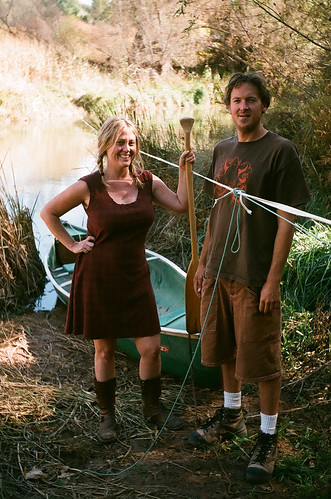
Noise favorite Natasha Shealy has returned to the Verde Valley from her North Carolina home in order to participate in saving Eliphante. According to Ms. Shealy, “Eliphante needs to be protected and used to inspire. I struggled with this, feeling it might be best returned to the riverbank it came from. But I feel Eliphante needs to be identified as a community asset and international folk art treasure. Many in the international folk art world would be inspired and astounded.”
"We cannot live how Michael did,” says John Bianchini, “but we recognize its value and seek to reconcile the two forces. When a commercial operation can be established to bring in income for Eliphante, we plan to focus on Eliphante's immediate repairs while working to purchase some surrounding acreage if available then to create an artistic eco-village.”
There are many ways you can become involved in the preservation of Eliphante.
They have a weekly Sunday evening potluck, and work party sessions each Tuesday and Sunday, where volunteers can help create, build, restore, and repair.
Volunteer: call Alna Laurel at (928) 634- 4707,
or Ryan Matson, Tracy Schinagel, and John Bianchini at (928) 634- 2687.
To assist in repairing the roof of the original building, "Eliphante", contact volunteer coordinator: Michael Lanning at (928) 284- 8884
Donate: make check payable to “Eliphante Limited”, and mail to PO box 971,Cornville, AZ 86325
Online: Roadrunnerspeaks.org. Also be sure to join “Eliphante Village” on Facebook.
Other: Donating special knowledge or skills is also greatly needed and appreciated. In particular: non-profit legal advice, film-making for publicity and fund-raising, grant-writing, and special construction skills such as rock-work, roof-work, reinforcing of highly unusual post and beam connections, electrical engineering and plumbing work.Eliphante Ltd. is also seeking volunteers to organize and staff fund-raising events in January, February, and March 2011.
“Eliphante remains a place where one can go to feel re-inspired and have their sense of magical possibilities refreshed, and for this reason alone, it is worthy of preservation,” says Alna Laurel, “Add to that its potential as a venue for awakening people's creative spirit and teaching how to let it blossom, and it becomes an urgent need in the present state of chaos and banality much of our society is experiencing. Where the human spirit feels acknowledged and empowered, there hope and renewal are born and sustained.”
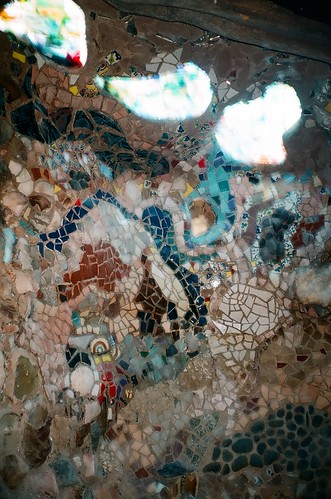
Ellen Jo Roberts thinks Eliphante is the bees knees.
She lives in a historic home made of Verde River sand bricks in Clarkdale Arizona with
Bike Daddy Chad, Cool Clyde, “Five Pounds of Fury” Floyd, and Slobber Face Ivan. Read all about it at Ellenjo.com.


lovely and amazing!
ReplyDeleteIt is such a shame that ALL humans can't spend their time creating in such a true form of spiritually artistic worldly realm. Being true to their inner most heartbeat, just slightly out of sink with the rest of the universe. Ah, the possibilities would be endless.
ReplyDeleteNice opinion on Plumber In Salinas.Thanks for sharing.
ReplyDelete